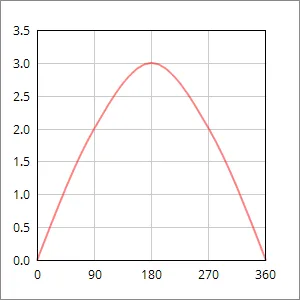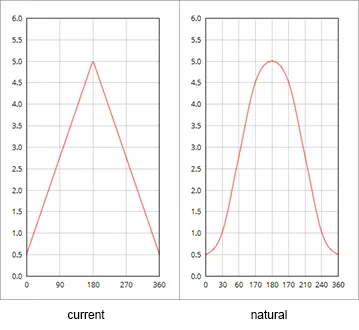我正在尝试在以下动画中模拟万有引力/加速度。随着地球接近太阳,它的角速度应该增加,远离太阳时则减小。我认为需要一个缓动函数来修改
我不知道已定义的缓动函数或自定义函数是否可行。我需要的缓动函数应该像这张图表一样:
earth.angularVelocity,但不知道如何实现。我不知道已定义的缓动函数或自定义函数是否可行。我需要的缓动函数应该像这张图表一样:

earth的近日点位于180°,远日点位于0/360°。我该如何创建这样的函数并使其正常工作?function pullRelease(angularPosition, begin, change, maxVelocity) {
// ?
}
earth.angularVelocity = pullRelease(earth.angularPosition, 0, 360, 3);
var canvas = document.getElementById("canvas");
var context = canvas.getContext("2d");
var sol = {
x: 125,
y: 150,
r: 30,
fill: "gold",
};
var orbit = {
x: 200,
y: 150,
semiMajor: 150,
semiMinor: 75,
};
var earth = {
r: 15,
fill: "dodgerblue",
angularPosition: 0,
angularVelocity: 1,
};
// draw sun
context.beginPath();
context.arc(sol.x, sol.y, sol.r, 0, 360 * Math.PI / 180);
context.fillStyle = sol.fill;
context.fill();
// draw fake sun to mark the orbit center
context.beginPath();
context.arc(orbit.x, orbit.y, sol.r, 0, 360 * Math.PI / 180);
context.fillStyle = "rgba(255,215,0,.1)";
context.fill();
// draw earth's orbit path
context.beginPath();
context.ellipse(orbit.x, orbit.y, orbit.semiMajor, orbit.semiMinor, 0, 0, 2 * Math.PI);
context.stroke();
// these are fixed, so save them as background-image
canvas.style.backgroundImage = "url(" + canvas.toDataURL() + ")";
function draw() {
context.resetTransform();
context.clearRect(0, 0, canvas.width, canvas.height);
var newPosition = rotate(-earth.angularPosition, orbit.semiMajor, orbit.semiMinor, orbit.x, orbit.y);
earth.x = newPosition.x;
earth.y = newPosition.y;
// earth.angularVelocity = pullRelease(earth.angularPosition, 0, 360, 3);
earth.angularPosition += earth.angularVelocity;
if (earth.angularPosition >= 360) {
earth.angularPosition = 0;
}
position.innerHTML = earth.angularPosition + "°";
context.translate(earth.x, earth.y);
context.beginPath();
context.arc(0, 0, earth.r, 0, 360 * Math.PI / 180);
context.closePath();
context.fillStyle = earth.fill;
context.fill();
requestAnimationFrame(draw);
}
requestAnimationFrame(draw);
function rotate(angle, distanceX, distanceY, originX, originY) {
return {
x: originX + Math.cos(angle * Math.PI / 180) * distanceX,
y: originY + Math.sin(angle * Math.PI / 180) * distanceY,
}
}body {
background: gainsboro;
}
canvas {
background: white;
box-shadow: 1px 1px 1px rgba(0, 0, 0, .1);
}
#position {
display: inline-block;
width: 35px;
text-align: right;
}<canvas id="canvas" class="box" width="400" height="300"></canvas>
<p>Position: <span id="position">0</span></p>
earth(位置),它遵循固定的路径。我也希望它的速度是动态的。我认为我不需要复杂的物理计算,但需要某种缓动函数。我已经有一个工作的函数了,只需要一些改进。 - akinuri